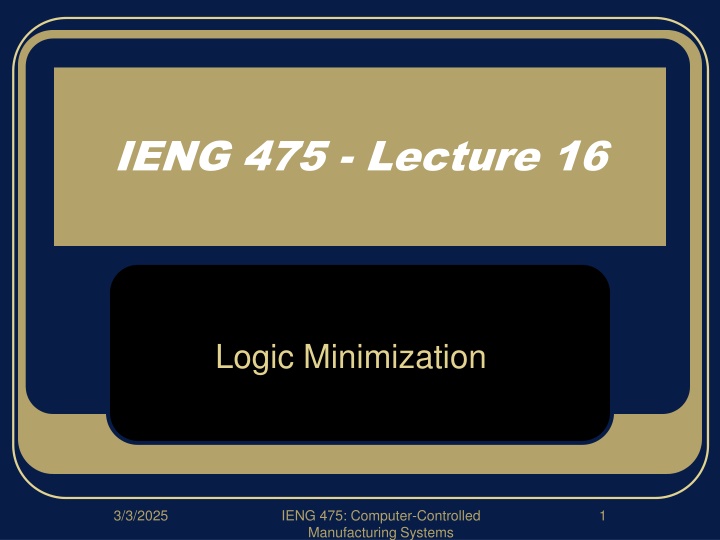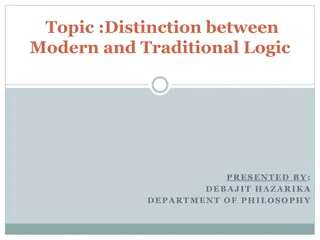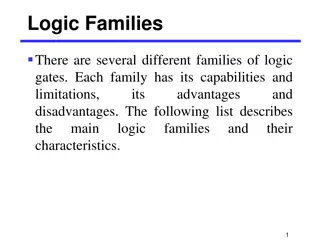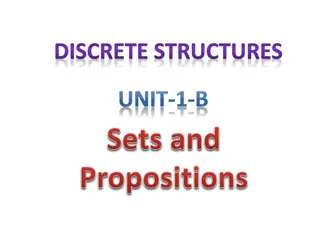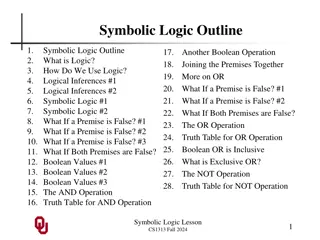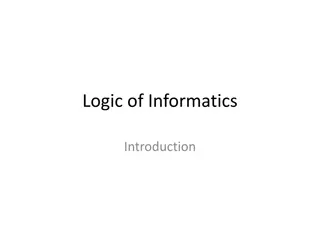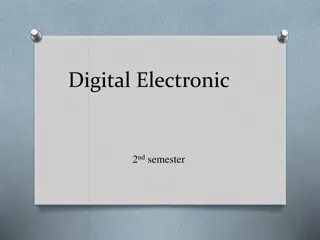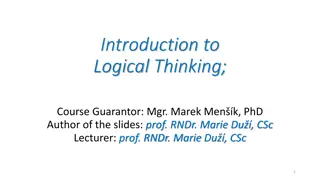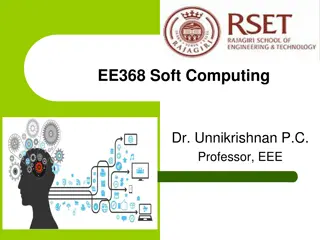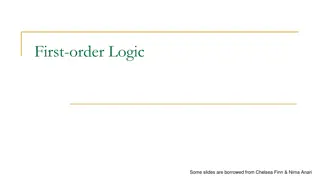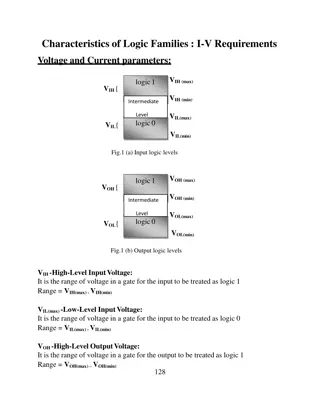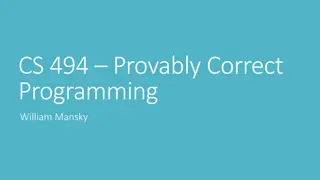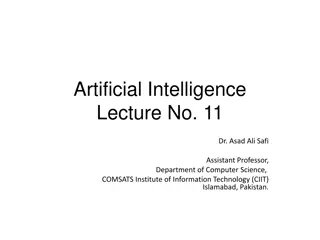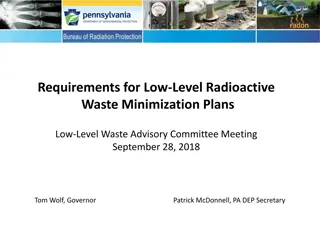Logic Minimization Techniques in Computer Systems
This content discusses the importance of logic minimization in designing computer-controlled manufacturing systems. It covers methods such as Karnaugh Maps for simplifying Boolean logic, considerations for simplification, and a review of PLC memory maps and scan times. The focus is on optimizing control system design through efficient logic minimization strategies.
Download Presentation

Please find below an Image/Link to download the presentation.
The content on the website is provided AS IS for your information and personal use only. It may not be sold, licensed, or shared on other websites without obtaining consent from the author.If you encounter any issues during the download, it is possible that the publisher has removed the file from their server.
You are allowed to download the files provided on this website for personal or commercial use, subject to the condition that they are used lawfully. All files are the property of their respective owners.
The content on the website is provided AS IS for your information and personal use only. It may not be sold, licensed, or shared on other websites without obtaining consent from the author.
E N D
Presentation Transcript
IENG 475 - Lecture 16 Logic Minimization 3/3/2025 IENG 475: Computer-Controlled Manufacturing Systems 1
Good Control System Design Clearly define signals, assigning good mnemonics and complete descriptions Set up truth table(s) Intelligently minimize logic gates and signals required Professionally diagram the control system(s) Carefully complete the system documentation ID and cross-reference signals, sources, sinks 3/3/2025 2 IENG 475: Computer-Controlled Manufacturing Systems
Logic Simplification Why simplify: Price of real estate (gates take space, cost of space) Less complex is easier to maintain (fewer gates) Avoid errors (in logic) Why NOT to simplify: Price of real estate (FPGA / ROM chips take little space) Less complex is easier to maintain (obfuscated logic) Avoid errors (in minimizing logic) Might be best to design both ways, and carefully evaluate the trade-offs 3/3/2025 3 IENG 475: Computer-Controlled Manufacturing Systems
Simplification Methods Boolean Logic See link on Materials page (put in notebook) Karnaugh Maps Depends on logical adjacency Output = B A + B A Output = B (A + A) Output = B 1 Output = B Depends on pattern recognition ability Usually best when 4 variables (although 5 or 6 variables, and MEV methods could be employed) 3/3/2025 4 IENG 475: Computer-Controlled Manufacturing Systems
Review: PLC Memory Map Output Image Table Output Block Input Block Input Image Table Internal Processor Work Area(s) User Program (Rungs) 3/3/2025 5 IENG 475: Computer-Controlled Manufacturing Systems
Review: PLC Scan Time Time to complete one processing cycle Typically on the order of milliseconds Depends on length of program Scan Time Diagrammed: Update Output Image Table Repeat Cycle I/O Scan Update Input Image Table Scan Time Logic (rung) Evaluation Program Scan 3/3/2025 6 IENG 475: Computer-Controlled Manufacturing Systems
Karnaugh Map Example #1 Steps: Set up Truth Table to cover all possible state of I/O Left side is Inputs and Current Output states Right side is Next Output state Show a 1 only when you want to turn the Output on Truth Table Inputs A 0 0 1 1 Output Q 1 1 1 B 0 1 0 1 3/3/2025 7 IENG 475: Computer-Controlled Manufacturing Systems
Karnaugh Map Example #1 Steps: Convert the Truth Table to Karnaugh Map Labels are the pattern of Inputs/Current Output states (Grey Scale) Cell entries are the 1 s of the Next Output State Truth Table Inputs A 0 0 1 1 Output Q 1 1 1 B 0 1 0 1 Karnaugh Map B 0 1 0 1 1 A 1 1 Q = 3/3/2025 8 IENG 475: Computer-Controlled Manufacturing Systems
Karnaugh Map Example #1 Steps: Interpret the Karnaugh Map Group the 1s into the largest power of 2 adjacent members: (1, 2, 4, 8, 16 ) Read the groups: Connection within group members is AND ( ) Connection between groups is OR (+) Equation is written as Sum of Products Truth Table Inputs A 0 0 1 1 Output Q 1 1 1 B 0 1 0 1 Karnaugh Map B shows up in both 0 and 1, within group, so it drops out B 0 1 0 1 1 A A shows up in both 0 and 1, within group, so it drops out 1 1 A B + Q = 3/3/2025 9 IENG 475: Computer-Controlled Manufacturing Systems
Karnaugh Map Example #2 Steps: Set up Truth Table to cover all possible state of I/O Left side is Inputs and Current Output states Right side is Next Output state Show a 1 only when you want to turn the Output on Truth Table Inputs A 0 0 0 0 1 1 1 1 Output Q B 0 0 1 1 0 0 1 1 C 0 1 0 1 0 1 0 1 1 1 1 1 3/3/2025 10 IENG 475: Computer-Controlled Manufacturing Systems
Karnaugh Map Example #2 Steps: Convert the Truth Table to Karnaugh Map Labels are the pattern of Inputs/Current Output states (Grey Scale) Cell entries are the 1 s of the Next Output State Truth Table Inputs A 0 0 0 0 1 1 1 1 Output Q B 0 0 1 1 0 0 1 1 C 0 1 0 1 0 1 0 1 1 1 1 1 Karnaugh Map B C 0 0 0 1 1 1 1 0 0 1 1 A 1 1 1 Q = 3/3/2025 11 IENG 475: Computer-Controlled Manufacturing Systems
Karnaugh Map Example #2 Steps: Interpret the Karnaugh Map Group the 1s into the largest power of 2 adjacent members: (1, 2, 4, 8, 16 ) Read the groups: Connection within group members is AND ( ) Connection between groups is OR (+) Equation is written as Sum of Products Truth Table Inputs A 0 0 0 0 1 1 1 1 Output Q B 0 0 1 1 0 0 1 1 C 0 1 0 1 0 1 0 1 A shows up as only as a 1 & B shows up only as a 1 in group, but C shows up in both 0 and 1, within group, so it drops out 1 1 1 1 Karnaugh Map B C A & C show up only as 1s in the group, but B shows up in both 0 and 1, within group, so it drops out 0 0 0 1 1 1 1 0 0 1 1 A 1 1 1 A C A B + Q = 3/3/2025 12 IENG 475: Computer-Controlled Manufacturing Systems
Karnaugh Map Example #3 Truth Table Inputs A 0 0 0 0 1 1 1 1 Output Q 1 Karnaugh Map B 0 0 1 1 0 0 1 1 C 0 1 0 1 0 1 0 1 B C 0 0 0 1 1 1 1 0 1 1 0 1 1 1 A 1 1 B C + A C Q = 1 These ends of the K-map are also adjacent (they only change by one bit position), so they can be grouped. A and C both show up only as 1s in the group so they stay, but B shows up in both 0 and 1 within group, so it drops out A shows up in both 0 and 1, within group, so it drops out, leaving B and C both showing up only as 1s (so they stay in) 3/3/2025 13 IENG 475: Computer-Controlled Manufacturing Systems
Karnaugh Map Example #4 Truth Table Karnaugh Map C D Inputs A 0 0 0 0 0 0 0 0 1 1 1 1 1 1 1 1 Output Q 0 0 0 1 1 1 1 0 B 0 0 0 0 1 1 1 1 0 0 0 0 1 1 1 1 C 0 0 1 1 0 0 1 1 0 0 1 1 0 0 1 1 D 0 1 0 1 0 1 0 1 0 1 0 1 0 1 0 1 0 0 1 0 1 1 A B 1 1 1 1 1 1 0 1 1 1 A D C D + Q = A & D both show up only as 1s in the group (they stay), but B & C show up in both 0 and 1, within group, so they drop out C & D both show up only as 1s in the group so they stay, but A & B show up as both 0 and 1 within group, so they drop out It is OK for groups to overlap in order to get larger groupings in powers of 2 1 1 1 1 3/3/2025 14 IENG 475: Computer-Controlled Manufacturing Systems
Karnaugh Map Example #5 Truth Table Karnaugh Map C D Inputs A 0 0 0 0 0 0 0 0 1 1 1 1 1 1 1 1 Output Q 0 0 0 1 1 1 1 0 B 0 0 0 0 1 1 1 1 0 0 0 0 1 1 1 1 C 0 0 1 1 0 0 1 1 0 0 1 1 0 0 1 1 D 0 1 0 1 0 1 0 1 0 1 0 1 0 1 0 1 0 0 0 1 1 A B 1 1 1 1 1 0 1 1 1 A D B C D + Q = B & C & D all show up only as 1s in the group so they stay, but A shows up as both 0 and 1 within group, so it drops out It is OK for groups to overlap in order to get larger groupings in powers of 2 1 A & D both show up only as 1s in the group (they stay), but B & C show up in both 0 and 1, within group, so they drop out 1 1 1 3/3/2025 15 IENG 475: Computer-Controlled Manufacturing Systems
Karnaugh Map Example #6 Truth Table Karnaugh Map C D Inputs A 0 0 0 0 0 0 0 0 1 1 1 1 1 1 1 1 Output Q 1 0 0 0 1 1 1 1 0 B 0 0 0 0 1 1 1 1 0 0 0 0 1 1 1 1 C 0 0 1 1 0 0 1 1 0 0 1 1 0 0 1 1 D 0 1 0 1 0 1 0 1 0 1 0 1 0 1 0 1 0 0 1 1 0 1 1 A B 1 1 1 0 1 1 1 1 A B + B C 1 1 1 1 Q = These four ends of the K-map are also adjacent (they only change by one bit position), so they can be grouped. A & B both show up only as 1s (so they stay), but both C & D show up as both 0 and 1, within group, so they drop out B & C both show up only as 1s in the group so they stay, but A & D both show up in both 0 and 1 within group, so they drop out 3/3/2025 16 IENG 475: Computer-Controlled Manufacturing Systems
Karnaugh Map Example #7 Karnaugh Map Truth Table The is a symbol for Don t Care . They can be included if it makes a group larger by a power of 2, but do not have to be covered C D Inputs A 0 0 0 0 0 0 0 0 1 1 1 1 1 1 1 1 Output Q 0 0 0 1 1 1 1 0 B 0 0 0 0 1 1 1 1 0 0 0 0 1 1 1 1 C 0 0 1 1 0 0 1 1 0 0 1 1 0 0 1 1 D 0 1 0 1 0 1 0 1 0 1 0 1 0 1 0 1 0 0 0 1 1 A B 1 1 1 1 1 0 1 1 A D B C D + Q = B & C & D all show up only as 1s in the group so they stay, but A shows up as both 0 and 1 within group, so it drops out It is OK for groups to overlap in order to get larger groupings in powers of 2 1 A & D both show up only as 1s in the group (they stay), but B & C show up in both 0 and 1, within group, so they drop out 1 1 3/3/2025 17 IENG 475: Computer-Controlled Manufacturing Systems
Karnaugh Maps Summarized: Most efficiently cover all the map s 1 s Enter the 1 s (and Don t Cares ) into K-map for EACH output Circle the largest group of adjacent 1 s Shade the 1 s covered by the group Continue until all the 1 s in the map have been covered (circled & shaded) Don t Cares (X s or s) are covered and included ONLY if they make a grouping larger (simpler) by a power of 2 Be careful that what is specified as a Don t Care REALLY doesn t matter Evaluate the groupings to determine which variable(s) aren t needed both the variable & it s compliment (opposite) appear in grouping Express as the Sum Of Products from each grouping (minterm) 3/3/2025 18 IENG 475: Computer-Controlled Manufacturing Systems
System Documentation Example: Penguin Migration & Truck Garage System Definition Migration Ramp: N.O. through-beam photosensor input (PNGN HR) detects penguins as they waddle up the ramp to a truck to be driven to a safe location Truck will hold 33 000 penguins An output (CLS DR) closes the ramp door when the truck is full System Definition Truck Garage: N.O. through-beam photosensor input (TRCK HR) detects a truck driven into a garage Truck driver needs 1 minute of garage light (GRG LGHT) to exit garage An output (SHRK DR) opens the shark trap 10 s later to keep penguins on truck 3/3/2025 19 IENG 475: Computer-Controlled Manufacturing Systems
System Documentation Example: Penguin Wash Sequencer System Definition: N.O. N2OH4 sensor input (PNGN SMLL) detects a smelly penguin in the washer Penguin gets a 1 minute cold water spray with the drain opened, door closed Drain closes and Penguin tank gets filled with water and soap (2.5 minutes) Penguin gets a 4 minute soap & warm water wash, drain closed and spinner on Penguin gets a 3 minute warm water rinse as wash water drains (no agitation) Tank waits for 1 minute to fill w/ water & Penguin Softener, spinner on, drain closed Tank drains for 1.5 minutes with spin on Penguin is fluffed by hot air while spinning for 2 minutes Door opens and beeper signals that the clean penguin is available (for 10 seconds) Door stays open and system resets Outputs: A: Door Lock (1-closed, 0-open) B: Water Valve (1-opened, 0-closed) C: Soap Valve (1-opened, 0-closed) D: Drain Valve (1-opened, 0-closed) E: Spinner Motor (1-on, 0-off) G: Hot Air Blower (1-on, 0-off) F: Penguin Softener Valve (1-on, 0-off) H: Beeper (1-on, 0-off) 3/3/2025 20 IENG 475: Computer-Controlled Manufacturing Systems
System Documentation Example: Penguin Wash Sequencer Output Table Bit Address Outputs B C Step Count/ Dwell A D E F G H 1 1 0 0 0 0 0 0 600 0 1 1 0 1 0 0 0 0 1500 1 1 1 1 0 1 0 0 0 2400 2 1 1 0 1 0 0 0 0 1800 3 1 1 0 0 1 1 0 0 600 4 1 0 0 1 1 0 0 0 900 5 1 0 0 0 1 0 1 0 1200 6 0 0 0 0 0 0 0 1 100 7 3/3/2025 21 IENG 475: Computer-Controlled Manufacturing Systems
System Documentation Example: Circuit Diagram (PLC Rungs, Pt. 1) C33 CTU PNGN HR CU R PV RSTRT +32 000 C34 CTU PNGN HR C33 CU R PV RSTRT +1 000 CLS DR C34 3/3/2025 22 IENG 475: Computer-Controlled Manufacturing Systems
System Documentation Example: Circuit Diagram (PLC Rungs, Pt. 2) T36 TOF TRCK HR IN PT 100ms + 600 GRG LGHT T36 T37 TON TRCK HR T36 IN PT 10ms +1 000 SHRK DR T37 901 (AB) PNGN SMLL SEQ RST RESET 100ms 3/3/2025 23 IENG 475: Computer-Controlled Manufacturing Systems
Questions & Issues 3/3/2025 24 IENG 475: Computer-Controlled Manufacturing Systems
